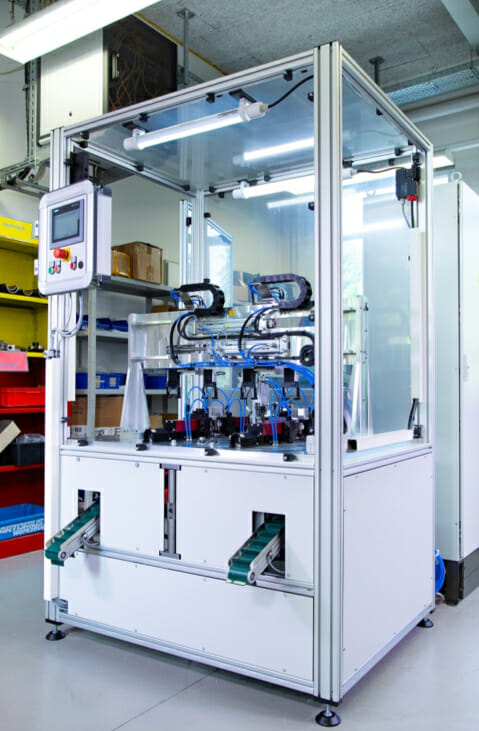As a leading provider of roller burnishing technology for metallic surfaces for over 35 years, Wenaroll, based in Solingen, Germany, has developed core technology competencies in the production of tools and machines for application specific solutions. The company has an established international market and client base including companies from sectors such as commercial vehicles, construction machinery, aerospace technology, mechanical engineering, the automotive industry and many others.
In a recent automated machine project for a new Russian customer, Wenaroll turned to Zimmer Group for the gripper systems and technology required to handle delicate lead battery terminals, as part of their turnkey solution.
This application required the design and manufacture of an automatic battery terminal burnishing machine, which uses roller burnishing to compress the surface of lead alloy battery terminal. The system comprises of a number of different elements including a frame, drive unit, machine base, roller units, gripper systems, feeding and sorting system and a control system complete with an operator interface.
The process begins with the presentation of the battery terminals from the feed unit. The Zimmer gripper unit then transports the terminals to the roller units where the actual burnishing process takes place. Once the terminals are clamped and rotated into position, the roller units move together, and the designated surfaces are hardened by the burnisher rolls applying a pre-defined amount of force. The roller burnishing process takes place at a maximum force of 255 newtons and a maximum speed of 400 rpm. The result of the process is impressive: The terminals are now gas-tight and have a surface with a roughness depth of Rz < 1 µm, with the processing time just 8 seconds per battery terminal.
(Wenaroll’s roller burnishing machine incorporates Zimmer Gripper Technology)
Zimmer’s gripper technology, in the form of four parallel grippers mounted on an aluminum frame, is one of the key components of the system. Zimmer Group UK’s Ian Sinclair comments: “The customer had very specific ideas when it came to the gripper design. The preference was for electric grippers with a single cable solution. It was essential that the grippers applied the smallest possible gripping force to prevent damage to the delicate surface of the lead battery terminal and to ensure that no defects would be left behind on objects being handled.”
(Zimmer’s GEP2000 Grippers perform the delicate handling tasks required)
A further requirement was the capability to use long gripper jaws or gripper fingers, as for certain components, the design required the option to insert gripper fingers deep into the device. In their quest for a suitable gripper solution, the customer’s development team selected Zimmer Group as its gripper specialist of choice, based upon Zimmer’s reputation and excellent quality.
Four models of Zimmer’s GEP2000 series (GEP2010IO-05-A) were specially selected for this application. These electrically driven small-part grippers are very easy to control and were primarily designed for handling small parts, such as the battery terminals in this application, or for other assembly tasks. This series of grippers series offer adjustable gripping forces between 40 N and 500 N and jaw strokes between 6 and 16 millimeters. In addition, the grippers feature a mechanical self-locking mechanism that prevents the loss of the battery terminals in the event of power failure.
(The complete gripping solution was designed and manufactured by Zimmer Group)
The superlative durability and reliability of Zimmer gripper technology is another factor that led Wenaroll to consider them as an option. The gripper housings are manufactured from hard-anodized aluminum, and for the guides, the developers rely on a flat guide that has been tried and tested for decades. These features combined allow 10 million cycles to be handled without the need for maintenance. The four individual grippers are not all that Zimmer Group delivered to Wenaroll for this application, Zimmer’s in-house Systems Department also developed and fabricated the complete gripper unit including the frame structure and wiring, etc.







